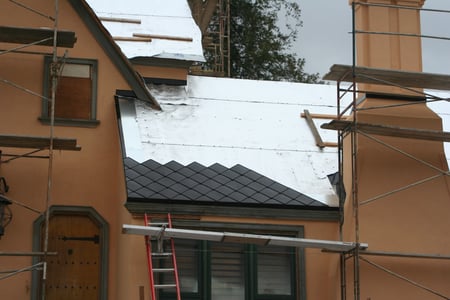We field a lot of inquiries in our blog post comments, and there tends to be quite a bit of repetition. There remain many misconceptions about metal roofing, and the idea that a metal roof might "catch" more heat from the sun than a non-metal roof is one of them. If you've ever wondered whether a metal roof makes a home hotter, the answer is no. Here's why.
 The Roof Material & Assembly
The Roof Material & Assembly
To fully explain, it's important to understand that there are two elements at play: the roof covering material (in this case, metal roofing) and the construction of the roof assembly.
When it comes to the heat absorbancy of metal, there are a few variables:
- Both the color and finish of the metal will impact its heat absorbancy. Metal exposed directly to the sun will most certainly heat up, but whether or not it will get hotter than other roofing materials relates to both the color and finish. The Energy Star finishes that most of our metal roof products use are certified to be reflective of sunlight, making them cooler than older finishes. Plus, a lighter color will absorb less heat than a dark color.
- It's true that a metal roof will absorb heat when directly exposed to the sun, but so will any roof covering material. A dark roof in asphalt, ceramic, slate or any other material absorbs heat at roughly the same rate. And it's unlikely that the same color in differing materials will result in a significant roof-top temperature difference.
- Once the sun stops hitting a roof directly, the lightest material loses its heat the fastest. The lightest roof available is metal, so it cools the fastest. Once the sun stops shining on a metal roof, it quickly reverts to the same temperature as the ambient air. The greater mass of materials like slate or concrete means they will retain heat much longer. And the longer they stay hot, the more heat transferred to the building beneath. In terms of roofing materials contributing to heat in a building, metal is certainly the best possible option once the sun stops shining.
The Attic Construction
We've established that roof color and material do affect the amount of heat collected by the roof. But the more significant contributor to that heat being conducted into a home is the type of construction between the roof and the occupied space beneath it.
If there's an attic, then controlling the temperature of the attic with a "cool" roof like metal is important. But even more important is the need for properly ventilation. Keeping the attic to within a few degrees of ambient air temperature means the insulation in the ceiling has the best chance of keeping the room from gaining heat from the ceiling. After proper ventilation, the next most important consideration is the ceiling insulation. The more you have and the higher the quality, the less heat from the attic will be conducted into the room below in the summer, and the less heat will be conducted the other way in the winter.
A Simple Test
Use a digital thermometer to take the temperature of the ceiling, walls and floors in various rooms of the house. You'll be able to see which surfaces are contributing the most heat to a given space.
Have a burning roofing question? Leave a comment here or call us directly. And for more information about metal roofing, check our Resources page for our re-roofing booklet and comparison sheets.



